
views
Cutting the Main Door Panel
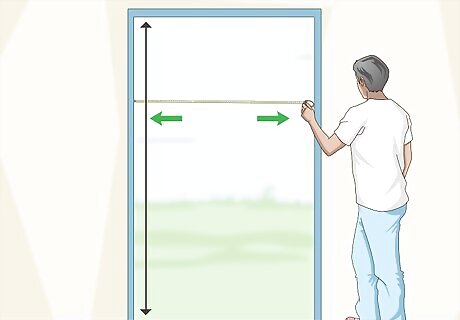
Measure the doorway where you’ll be installing your door. Before you get to sawing, gluing, and sanding, you’ll need to know exactly how big your door needs to be. Find the height and width of your empty doorway by running a tape measure down one side, then stretching it across the top. Make sure you jot your measurements down. You’ll need to refer back to them later while you’re cutting the panel for your door.
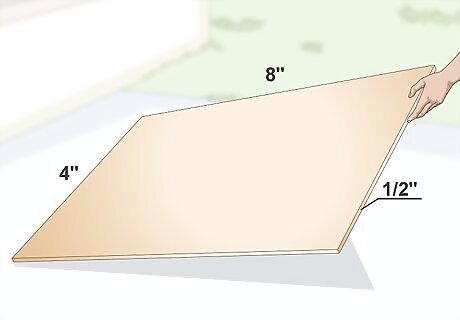
Acquire a 4 ft (1.2 m) x 8 ft (2.4 m) sheet of ⁄2 in (1.3 cm) plywood. Run down to your local hardware store or home improvement center and purchase a sheet of plywood to use as the main panel for your new door. For a standard interior door, ⁄2 in (1.3 cm) plywood will work best. A solid piece of plywood will create a door with a much sturdier construction than the hollow-bodied variety installed in most homes.
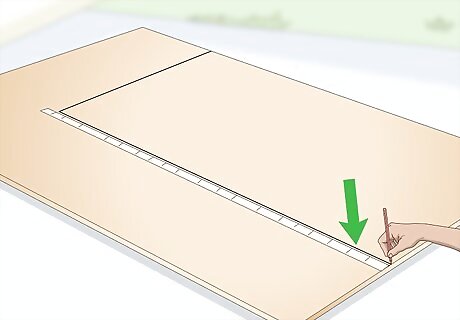
Mark the doorway dimensions on your plywood sheet with a pencil. Using the measurements you recorded earlier, draw one line down the length of the plywood corresponding to the height of the doorway and another line across the top to indicate the width. This will create a rough outline for your door panel. Use a ruler or straight edge to confirm that your lines are straight and precise. Otherwise, you could end up with a door that doesn’t fit!
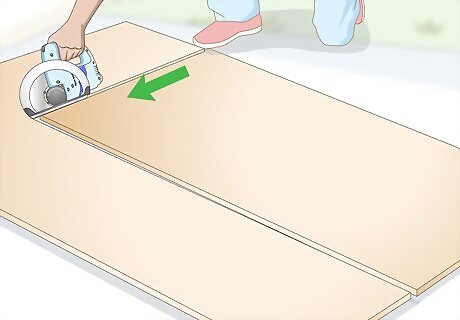
Cut the plywood to the correct dimensions using a circular saw. Guide the saw blade slowly over the plywood sheet along the height and width lines you just drew to trim the excess material from the edges. Depending on how your work bench is set up, you’ll need to reposition either the plywood or the saw when it comes time to make your second cut. Laying a separate piece of lumber along your measurement lines will ensure cleaner cuts and help prevent mistakes. The standard size of an interior door is 80 inches (200 cm) x 24–30 inches (61–76 cm). Safety First Always wear gloves and eye protection to keep yourself safe while operating a circular saw.
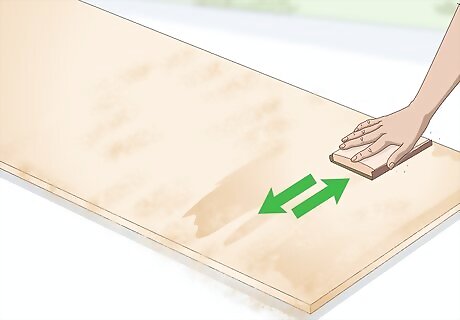
Sand the entire door panel. Run an electric sander or sheet of high-grit sandpaper over both sides of the panel, using even pressure to ensure that the outer surface is smooth and level. Once you’ve sanded both faces, turn your attention to the edges of the panel. You may have to clamp or brace the panel against another object to hold it steady while you sand the edges. At this point, you can either move on to painting and installing the mounting hardware if you’re satisfied with a plain, flat door, or cut a few more pieces of plywood to add textural accents to your blank panel.
Adding Accents to a Blank Door Panel
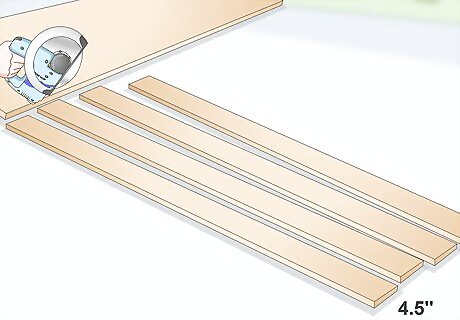
Cut your remaining plywood into 4–4.5 inches (10–11 cm) strips. Depending on how much plywood you have left over, you might decide to fashion a set of simple stiles and rails to give your door some added depth. If your main door panel is 80 inches (200 cm) tall and 25 inches (64 cm) wide, you should have enough material left over for about 4 80 in (200 cm) x 4.5 in (11 cm) sections and 6 16 in (41 cm) x 4.5 in (11 cm) sections. Keep in mind that you’ll need to put stiles and rails on both sides of the door. Consider buying a second, smaller sheet of plywood to make sure you’ll have enough and account for possible waste. Know Your Anatomy Stiles are thin pieces of wood arranged vertically to frame the sides of a door. Similarly, rails are placed across the top, bottom, and center of the door to complete the framing and provide a sense of symmetry.
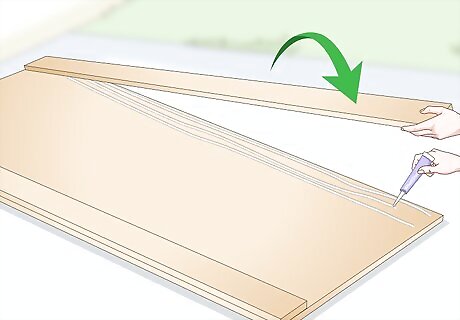
Attach the stiles to the edges of the panel using construction adhesive. Apply 2-3 stripes of adhesive down the length of both sides of the panel. Then, line up an 80 in (200 cm) x 4.5 in (11 cm) strip over either edge and press them down into the glue. Keep steady pressure on the stile pieces for 3-5 minutes, or until the adhesive has set enough to hold them in place. It may help to clamp the stiles to the door panel using a vice or a pair of table clamps. Not only will this keep pressure on the plywood pieces while the adhesive sets, it will also leave you with both hands free. Once the adhesive has set completely, turn the panel over and attach the 2 remaining stile pieces to the opposite side.
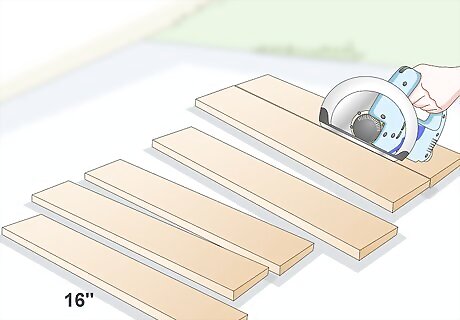
Saw your remaining plywood strips into 6 16 in (41 cm) sections. These sections will serve as your rails. Once you’ve cut them, they’ll fit right between the stiles, which should be exactly 16 inches (41 cm) apart. Measure and cut each of your rails separately to make sure they all come out the same size.
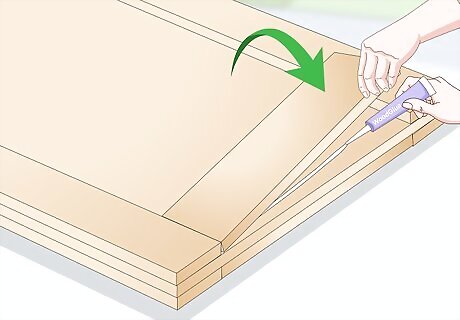
Glue the rails into place on the door panel. Apply 1-2 lines of glue on the backside of each of your rail pieces and position them in between the stiles at the top, bottom, and center of the door. Clamp one set of rails at a time before moving onto the next set. Remember, you’ll need to do this on both sides of the door. To make sure your center rail is situated correctly, draw a line widthwise through the midpoint of the panel, or the 40 in (100 cm) mark, and use it as a reference when setting and gluing the rail. Use a heavy object with a flat bottom to serve as a makeshift clamp and maintain pressure on the center rails.
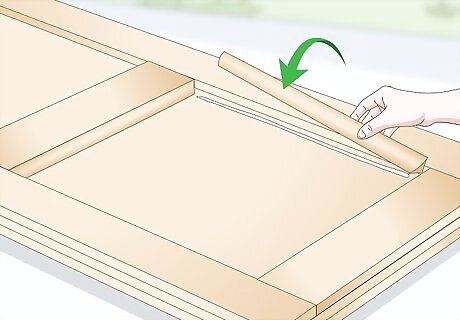
Add decorative trim to give your door more visual appeal (optional). If you want to give your door a more polished look, purchase a few feet of wooden moulding in your preferred style and cut it to fit along the inner edges of the panel where the stiles and rails meet. In total, you’ll need 8 33.25 in (84.5 cm) pieces and 8 16 in (41 cm) pieces (4 for each side of the door). Glue these beside the stiles and rails. Saw the end of each section of trim at a 45-degree angle. That way, all of the pieces will fit together easily with no need to adjust their length. You can also use 1.25 in (3.2 cm) finishing nails in addition to your construction adhesive to provide added security.
Finishing and Hanging the Door
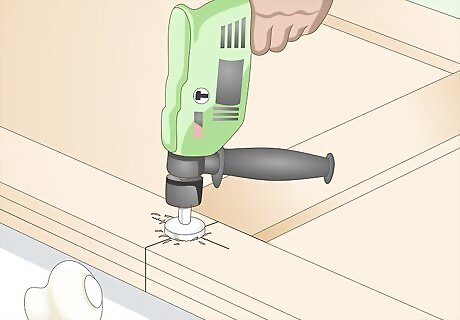
Bore holes for the lockset. Use a cordless drill with a 2.125 in (5.40 cm) hole saw attachment to open up a hole along the end of the door where the knob or handle will go. Drill halfway through one side, then flip the door over and finish boring through the opposite side. Once this is done, switch to a 1 in (2.5 cm) hole saw and drill directly into the edge of the door to make room for the latch. Maximum Efficiency For best results, consider investing in a hole-boring template. These screw into place at the edge of the door to simplify the lockset installation process and make your finished project neater and more efficient.
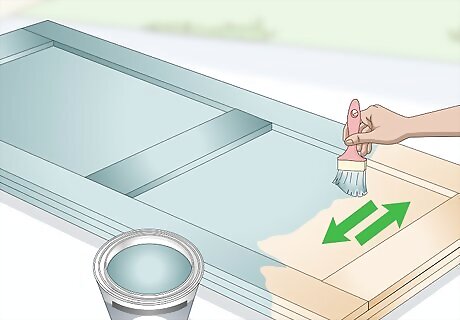
Paint or stain your door to enhance its appearance. Now that you’re done assembling your door, you can focus on giving it an eye-catching finish. Smooth on 2-3 coats of water-based alkyd paint in your shade of choice using a handheld sash brush, allowing the paint to dry between coats. Apply stains with a foam brush or rag and add or remove the stain a little at a time until you achieve the desired depth of color. Most water-based paints take about 24 hours to dry completely. If you opt to stain your door instead, it should be ready for a follow-up coat in 12-24 hours, depending on the product you’re using. Plan on using at least 2 coats to get the smoothest, most uniform finish possible.

Apply a water-resistant sealant if your door opens to the outside. If your door is intended for a garage, shed, workshop, or similar structure, it’s a good idea to weatherproof it before you put it up. Brush a clear coat of polyurethane sealant or wood varnish onto each of the door’s surface, including the outer edges. Use the tip of your brush to work the sealant deeper into grooved trim and other contoured areas. Exposure to the elements could cause your door to warp, crack, or split over time, ruining all of your hard work. Even if you’ll be hanging your door inside, a clear coat will prevent its finish from peeling or fading and keep it looking new for years to come. Sealants and varnishes tend to give off potent fumes. If possible, crack a window or leave nearby doors open to improve the ventilation in your workspace.
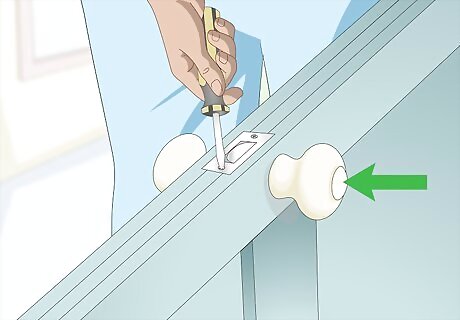
Install the latch and knob or handle. Slide the latch into the 1 in (2.5 cm) hole in the interior edge of the door and fasten it using the included screws. Align the 2 halves of the knob or handle on either side of the 2.125 in (5.40 cm) hole, then tighten the screws around the faceplate to secure it. If your latch hardware doesn’t sit flush with the edge of the door, you may need to cut a shallow mortise for it by chiseling out the area around it. This will allow it to seat directly into the wood. Be sure to insert the latch so that the rounded edge faces the door jamb. If you put it in backwards, you’ll have to turn the knob or handle all the way to get the door to close. If you're installing lever-type door hardware, make sure that it's right-side-up.
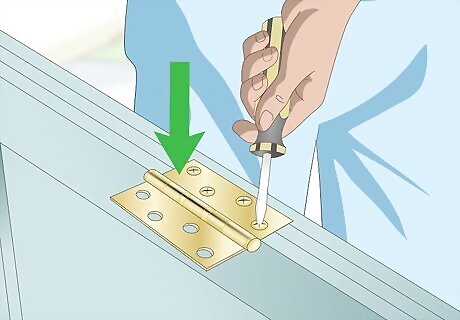
Attach the hinges. Use a tape measure to find the distance between the existing hinges on your doorframe. Position the new set of hinges on the inner edge of your door and trace around them with a pencil. Then, use a hammer and chisel to carve out a shallow mortise where each hinge will go. Finally, set the hinges in the depressions and screw them into place using a cordless drill. If there aren’t already hinges in the doorway where you’re hanging your door, you’ll need to install both sets at the same time. Consult a door installation guide or online hinge calculator to determine exactly where your door frame hinges need to go, and how far apart they should be spaced.

Mount your door by slotting its hinges into those on the door frame. All that’s left to do now is hang your completed door. Lift the door high enough to interlock both sets of hinges, then slide the hinge pins into the opening at the top each hinge and tap them down firmly. You’re done! Create improvised shims from wood scraps or folded pieces of cardboard to hold the door at the correct height while you fit the hinges together. Once you’ve hung your door successfully, open and close it a few times to make sure it moves smoothly on its hinges. If your feel any unusual resistance, you may need to take it down and try again.



















Comments
0 comment